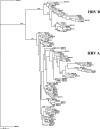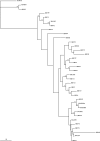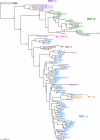Assay for 5' noncoding region analysis of all human rhinovirus prototype strains
- PMID: 18753359
- PMCID: PMC2576622
- DOI: 10.1128/JCM.00674-08
Assay for 5' noncoding region analysis of all human rhinovirus prototype strains
Abstract
Increasing recognition of the association of rhinovirus with severe lower respiratory tract illnesses has clarified the need to understand the relationship between specific serotypes of rhinovirus and their clinical consequences. To accomplish this, a specific and sensitive assay to detect and serotype rhinovirus directly from clinical specimens is needed. Traditional methods of serotyping using culture and serum neutralization are time-consuming, limited to certain reference laboratories, and complicated by the existence of over 100 serotypes of human rhinoviruses (HRVs). Accordingly, we have developed a sequence-based assay that targets a 390-bp fragment accounting for approximately two-thirds of the 5' noncoding region (NCR). Our goal was to develop an assay permitting amplification of target sequences directly from clinical specimens and distinction among all 101 prototype strains of rhinoviruses. We determined the sequences of all 101 prototype strains of HRV in this region to enable differentiation of virus genotypes in both viral isolates and clinical specimens. We evaluated this assay in a total of 101 clinical viral isolates and 24 clinical specimens and compared our findings to genotyping results using a different region of the HRV genome (the VP4-VP2 region). Five specimens associated with severe respiratory disease in children did not correlate with any known serotype of rhinovirus and were found to belong to a novel genogroup of rhinovirus, genogroup C. Isolates were also found that corresponded to the genogroup A2 variant identified in New York and Australia and two other novel group A clusters (GAC1 and GAC2).
Figures





References
-
- Cheuk, D. K., I. W. Tang, K. H. Chan, P. C. Woo, M. J. Peiris, and S. S. Chiu. 2007. Rhinovirus infection in hospitalized children in Hong Kong: a prospective study. Pediatr. Infect. Dis. J. 26995-1000. - PubMed
Publication types
MeSH terms
Substances
Associated data
- Actions
- Actions
- Actions
- Actions
- Actions
- Actions
- Actions
- Actions
- Actions
- Actions
- Actions
- Actions
- Actions
- Actions
- Actions
- Actions
- Actions
- Actions
- Actions
- Actions
Grants and funding
LinkOut - more resources
Full Text Sources
Other Literature Sources

